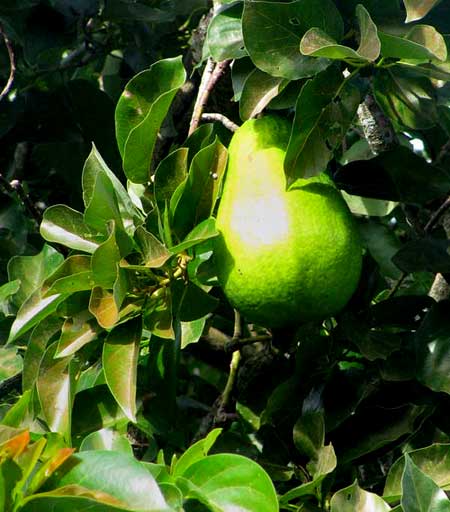
Deep in the dry season, in March or so, certain good-sized trees suddenly break out with diffuse, yellowish, basketball-size flower clusters, or inflorescences, such as those shown below:

These trees' leaves are about as nondescript as leaves get, so the sudden appearance of such conspicuous flower displays can be surprising. If you keep watching the inflorescences as the season progresses you'll see nearly all the tiny yellow flowers fall off, maybe with only one or two per cluster setting fruit, and you'll have the pleasure of watching the fruit develop. Then, about half a year later, toward the end of the rainy season, you'll see what's shown below:

That's an avocado on an Avocado Tree, Persea americana. In the Yucatan you see several different avocado cultivars. Some have smooth skin, others rough, some are small and the one in the picture is a big one, about eight inches long (20cm).
Avocados are native Mexican plants -- though not of the Yucatan -- and Mexico is by far the world's greatest exporter of them.
If you have an Avocado tree and want to try to identify which cultivar it is, a helpful piece of information is that Avocados come in two flowering types: "A" and "B". "A" cultivar flowers open as female on the morning of their first day and close in late morning or early afternoon. Then they open as male in the afternoon of the second day. "B" varieties open as female on the afternoon of their first day, close in late afternoon and reopen as male the following morning. Once you know whether you have an "A" or "B" type, you can rule out about half the other possible cultivars it might be. Help in identifying your cultivar can be found online by searching on the keywords "avocado cultivar identification."
Avocados belong to the Laurel Family, the Lauraceae, in which we also find Sassafras, Spicebush, Cinnamon-Tree and the Laurel itself, all fragrant and spicy species.